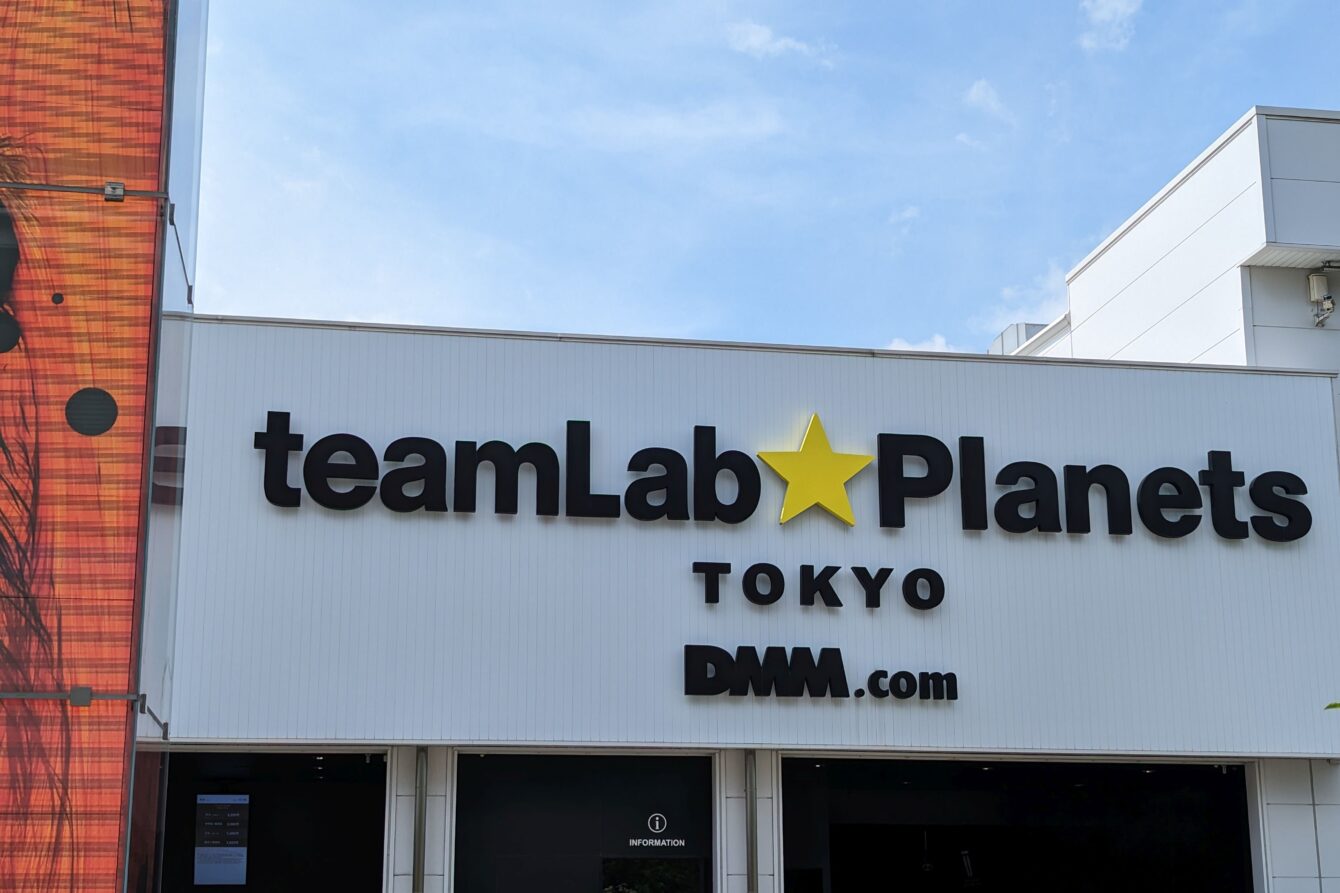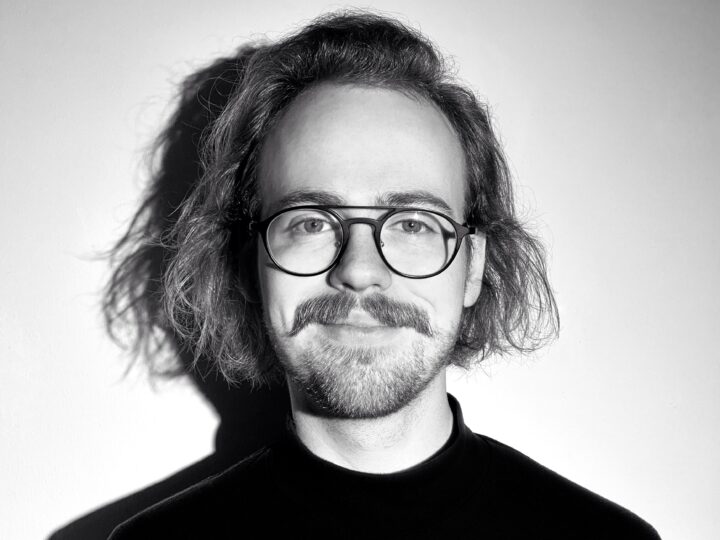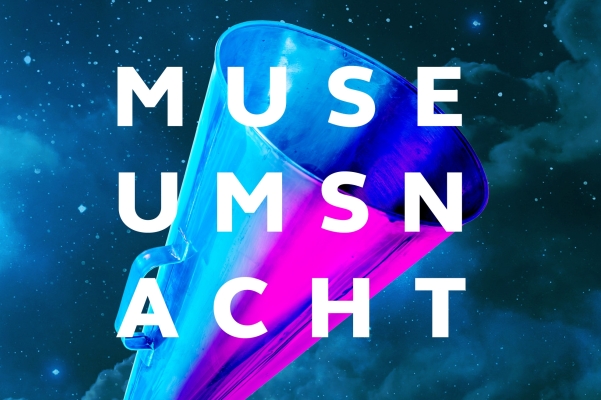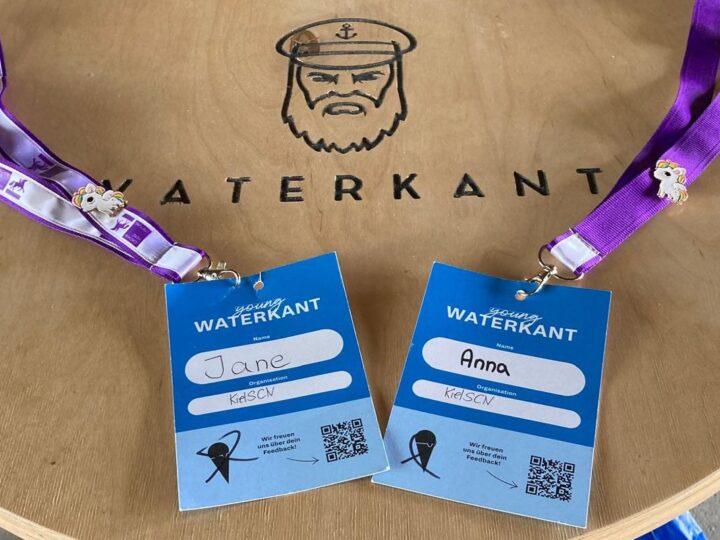VdM #12 – teamLab Planets Tokyo
Immerse, Perceive, Become One
Perceiving together with others and with the whole body – that is the motto of teamLab Planets Tokyo. Here, the artist collective teamLab has created an exhibition in which visitors walk barefoot through water, change the works with their presence and become one with nature in a garden area. Our KielSCN team member Heike Groth visited the exhibition, which we chose – for now – as our last visualization of the month.
A Very Unique Exhibition Visit
At the end of a trip to Japan, another very special event was on the agenda: a visit to teamLab Planets Tokyo. The exhibition starts in a water area with four large-scale artworks as well as two smaller installations, the “Waterfall of Light Particles at the Top of an Inclines” and the “Soft Black Hole”.
The waterfall, which is created in the dark from a combination of different afterimage traces, is located at the top of a slight incline that we walked through water. In the soft black space, there are no hard, flat surfaces. The feet sink in, making it difficult to move forward. At the same time, the other people in the room influence the texture of the surfaces with their movements. On the one hand, this leads to concentrating more on your own body and the room. On the other hand, it is important for your own path to focus more on the fellow human beings. Thus, the important principles of the exhibition are already made clear here: becoming one with the work and interacting with others.
The Infinite Crystal Universe
We then enter the infinite crystal universe. Using colored light points and mirrors, three-dimensional structures are created here that extend infinitely in all directions. The visitors and their individual location within the work influence the star-shaped structures. Using our own smartphones, we can select different structures ourselves and throw them into the infinite crystal universe. In this way, the artwork evolves permanently and in dependence on the individuals who interact at the time.
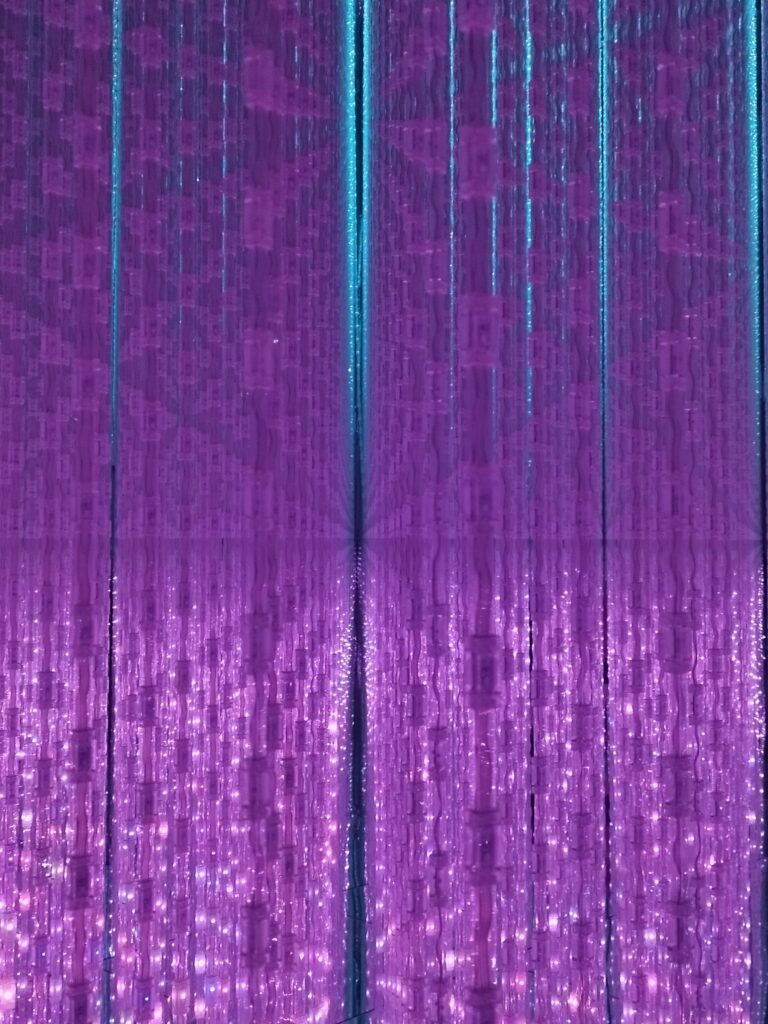
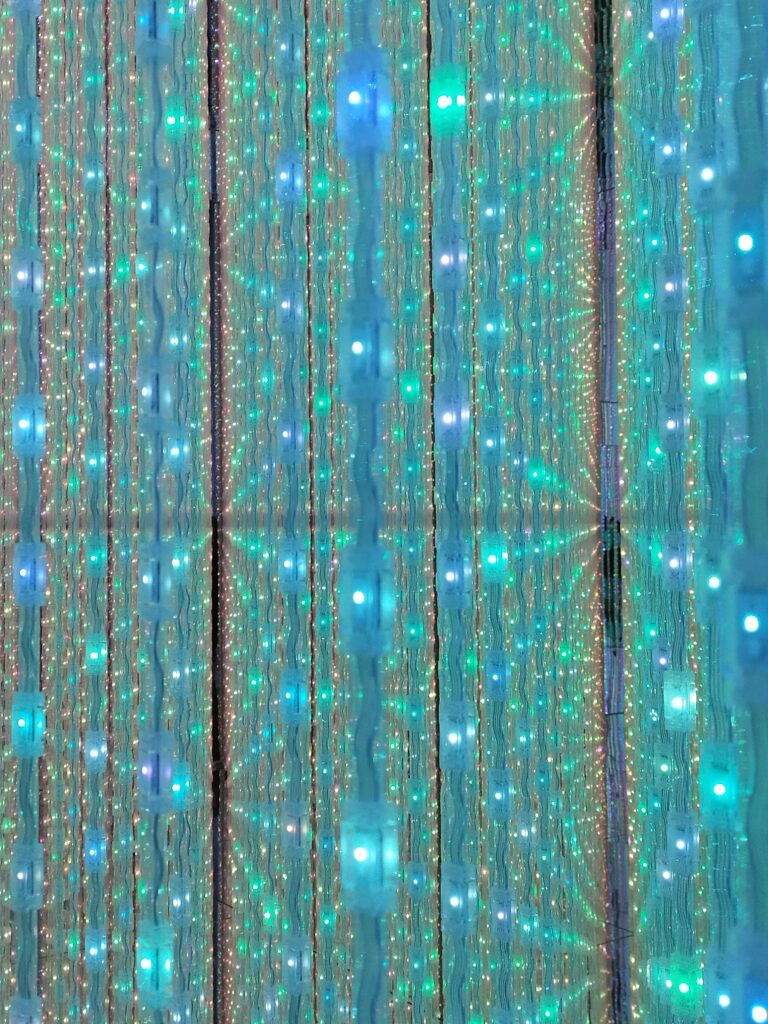
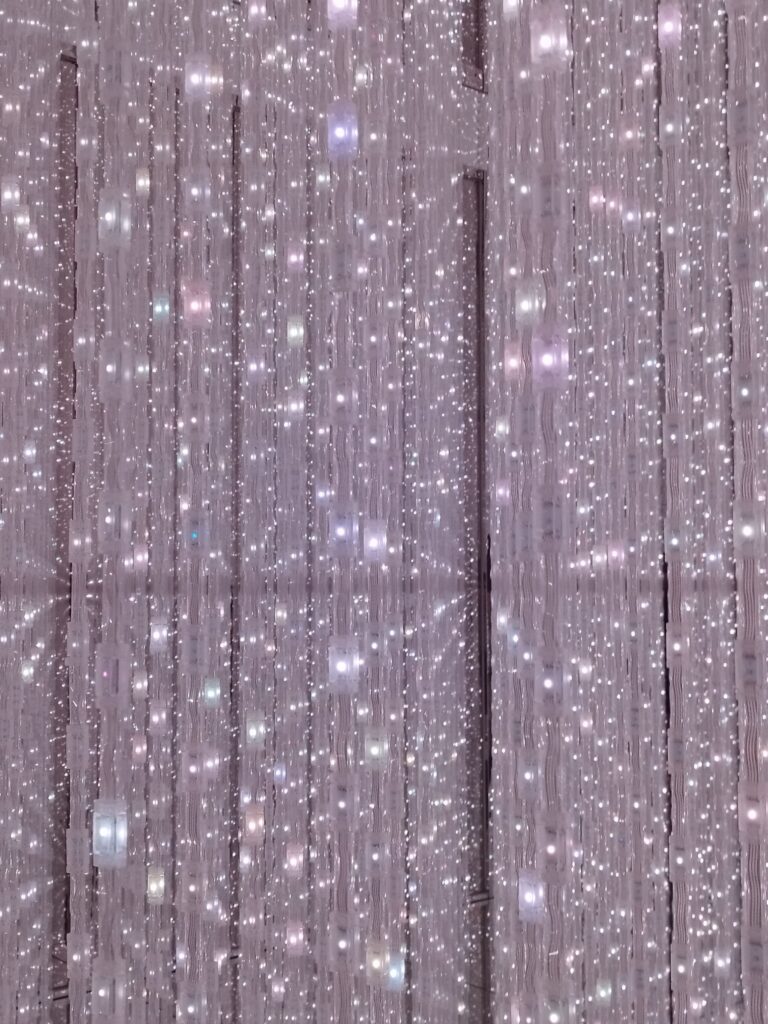
The Dance of Koi and Humans – Infinity
In the next room, milky water up to knee-deep awaits us. Colorful, digital koi fish swim on the surface. The presence of the people as well as the other koi influences their movements. Just as we touch one of the fish, collide with it, it turns into a flower and scatters. What we see at that very moment is rendered in real time by a computer program. The installation is constantly changing, because it is always the individual as well as the interaction of all those present, the snapshot, that makes up the artwork. Previous visual states can never be reproduced and will never be repeated as we have seen them.
Spheres of Free-Floating Light
We move on to the following room, which is filled with large, free-floating spheres of light. As in the previous rooms, there are mirrors on the floor and walls, so we seem to be completely immersed in these spheres of light. As people move around the room and touch the spheres, they change color. This change in shade is also transmitted to the surrounding spheres, which in turn transmit it three-dimensionally to the spheres adjacent to them. Since the sphere colors are created by light, it is possible to create a total of nine blurry colors. These are taken from nature and different seasons. For example, they represent the morning sky and the sky at dusk, but also plants such as peaches, plums and spring maple. In addition, there are three strong colors – blue, red and green – which visually flatten the space.
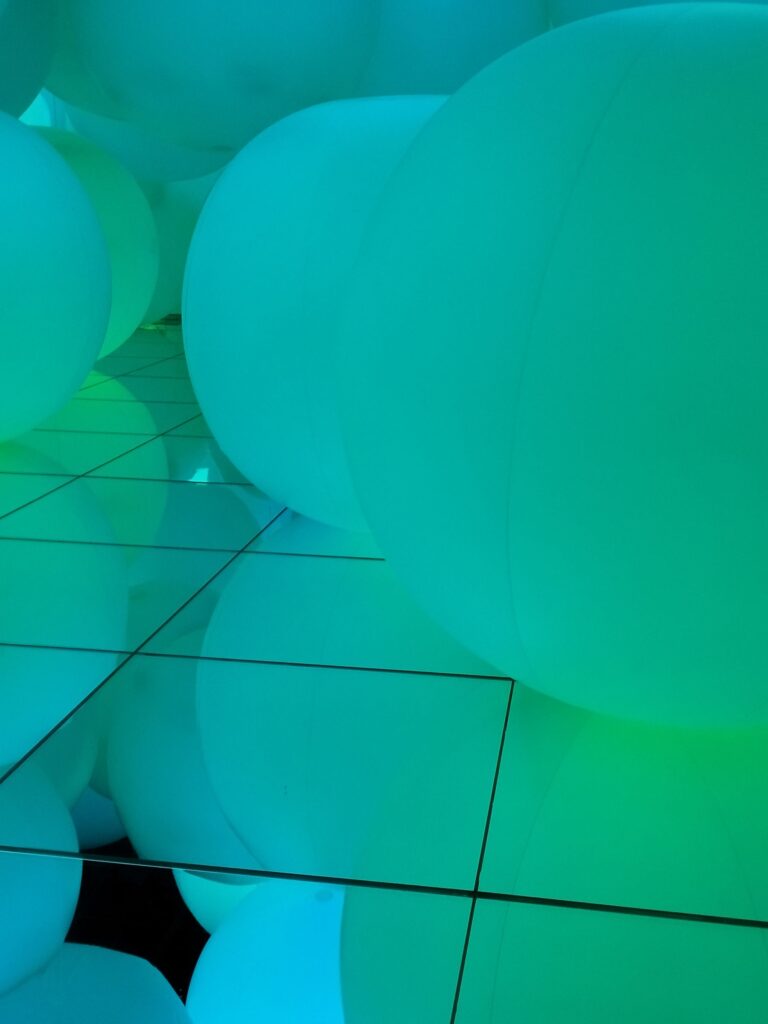
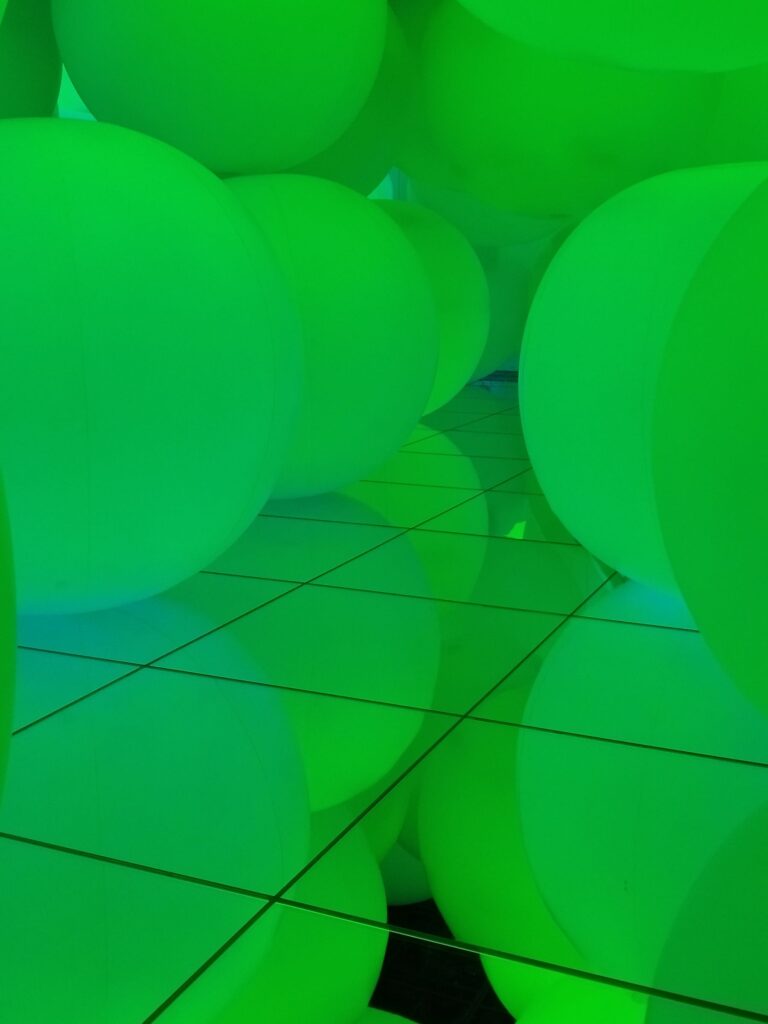
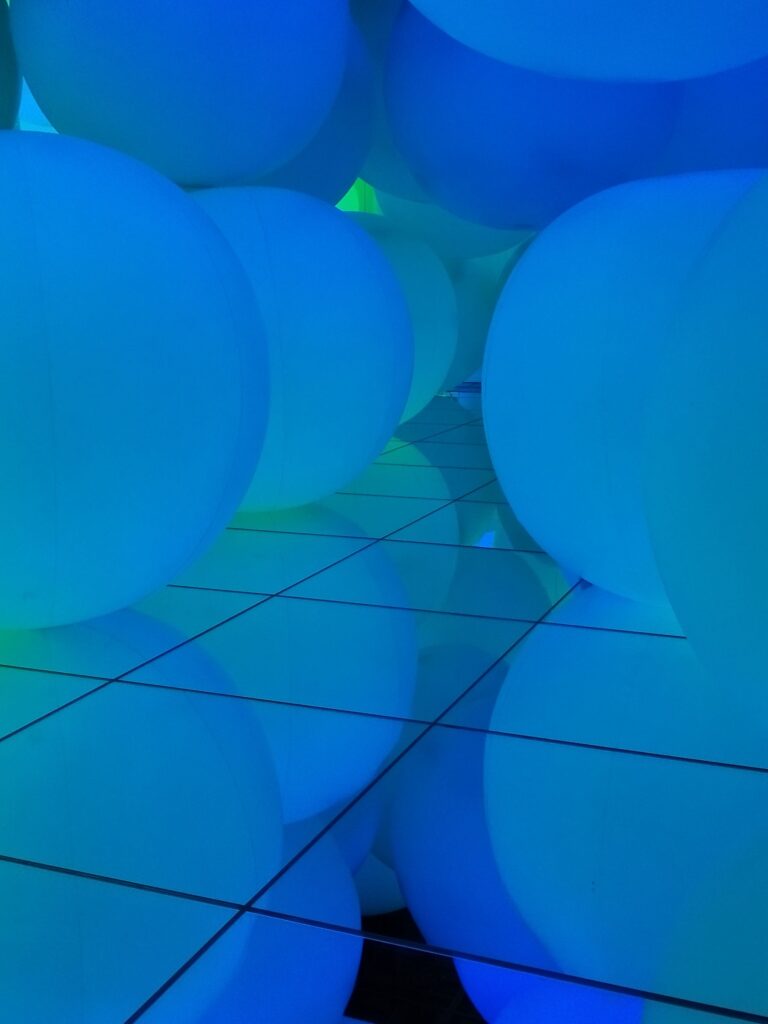
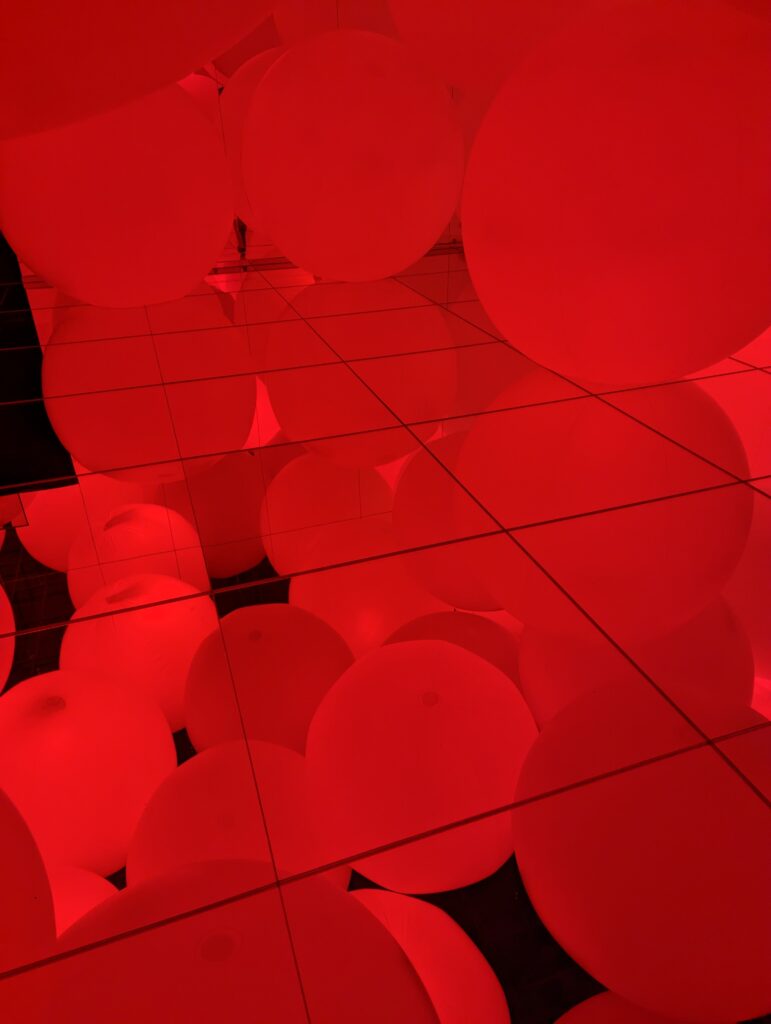
Floating in the Falling Universe of Flowers
The last digital installation in the water area is a 360° projection, which is again complemented by reflecting surfaces. We sit down on the floor and are surrounded by a sea of flowers. All arround us, they pass through the seasons and thus their natural cycle of life: they grow, develop buds, bloom and finally lose their petals, fade, die. Sitting on the floor, the boundaries dissolve and it feels as if we ourselves are moving in this universe of flowers.
Again, this work is not a pre-recorded video that is merely played. As with the koi fish before, a computer program continuously renders the artwork in real time. So it is constantly changing; previous visual states are never reproduced. The flower universe as we saw it at that moment can never be seen again in this way. What flowers are on view is based on the season of the visit.
The Moss Garden
Following the water area, with its primarily digital installations, is the garden area of the exhibition. In a moss garden in the outdoor area lie egg-shaped spheres that change their appearance according to the light conditions. Yet movement, in addition to light, also affects the spheres. When the wind touches them or people push them down, they release a resonating sound. A chain reaction is triggered and the surrounding spheres continue to vibrate with the same tone.
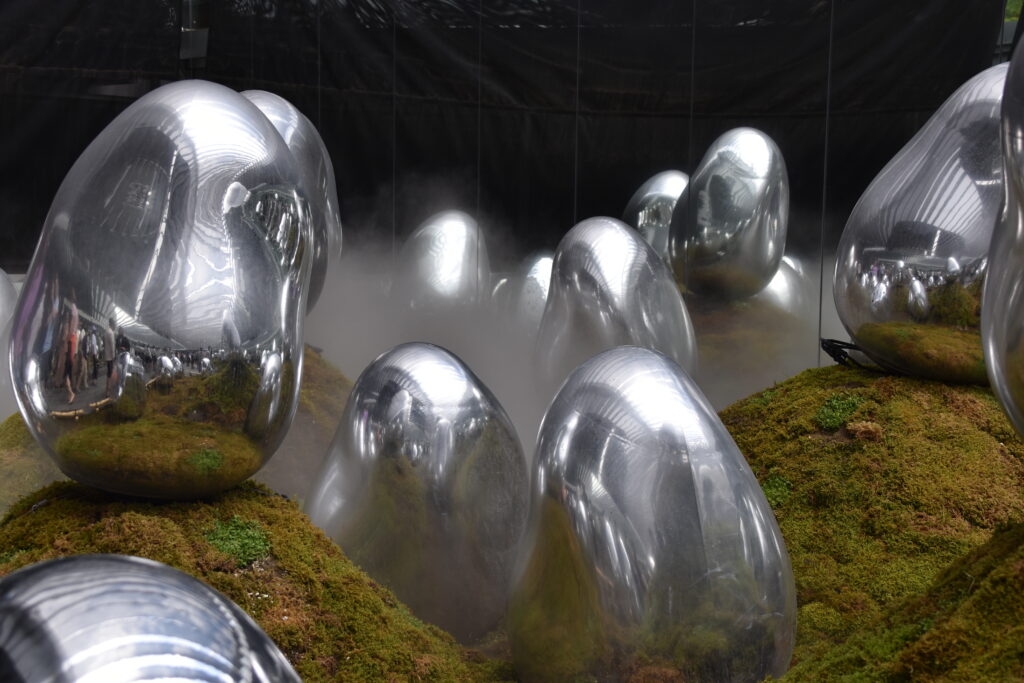
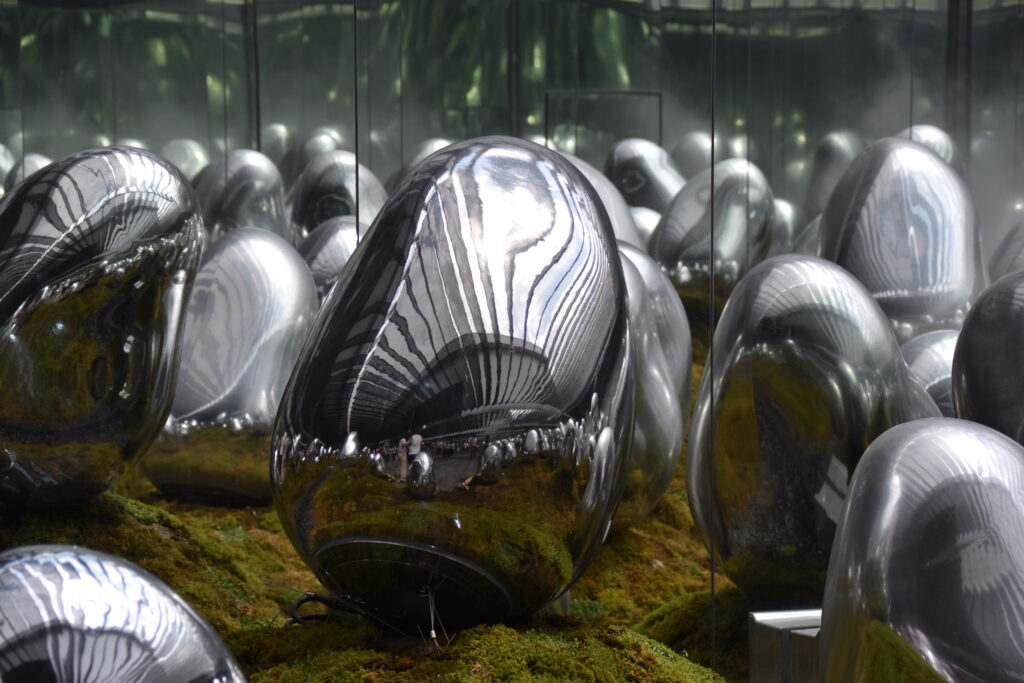
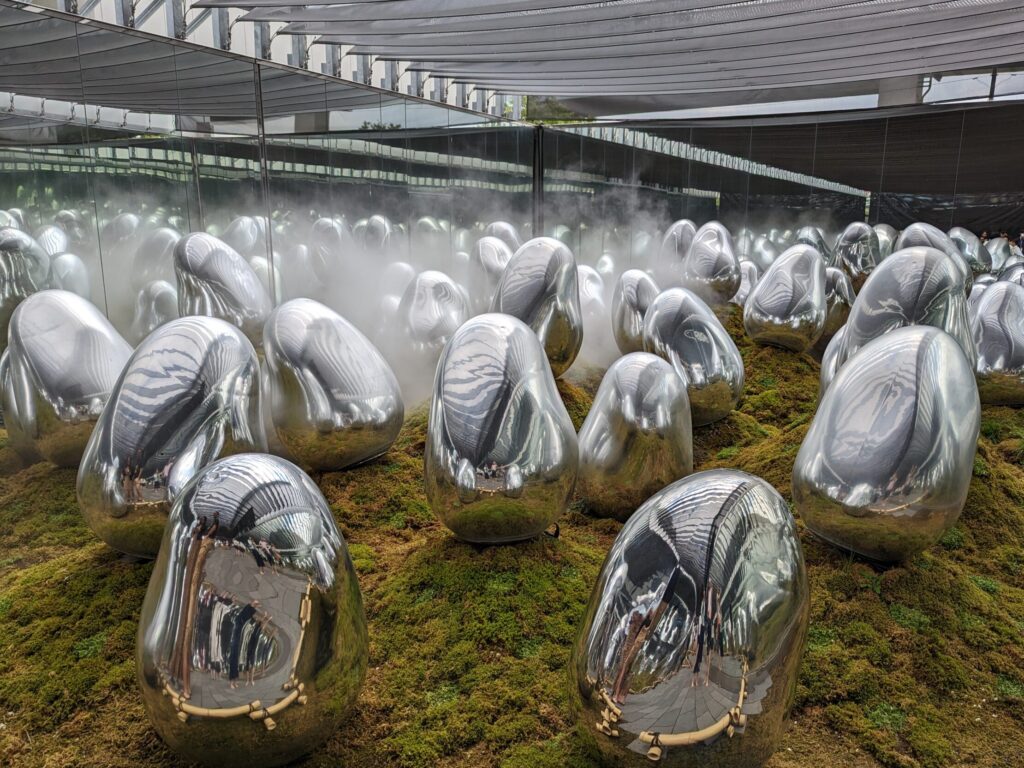
As the sun sets, the egg shapes additionally start to glow. Again, the touch of people or the wind triggers a reaction. Thus, they glow brighter, it starts to sound and the egg straightens up, as well as the neighboring ones. When there is no wind and people are very quiet, the egg-shaped objects slowly begin to flicker. So here, in addition to the people, it is the influence of wind and humidity that interactively shapes the installation. All three thus become part of the work. The moss in which the eggs lie also plays an important role. Mosses can largely adjust their water content to the moisture state of their environment. After long dry periods they come back to life as soon as they get water. And the color and shape of mosses also differ during drought, rain or fog.
The Floating Flower Garden
When we enter the last room we find ourselves in the middle of a sea of flowers from orchids. They hang down from the ceiling and are transformed into a large entity by mirrors on the walls as well as on the floor. All the flowers in this work of art are alive and almost seem to grow in the air. In the course of the day, the scent of the artwork changes, because different orchids are each being pollinated by certain insects carrying pollen. Depending on the time of day when they are active, the different flowers give off their scent.
In the floating flower garden, there are also touches of elements from Zen Buddhism. Zen gardens are places where priests used to practice becoming one with nature. A famous Zen monk is said to have said: “Heaven and earth and I are from the same root. All things and I are of the same substance.” All of that is echoed in this work, where we are immersed in the flowers hanging from the sky, becoming one with the garden.
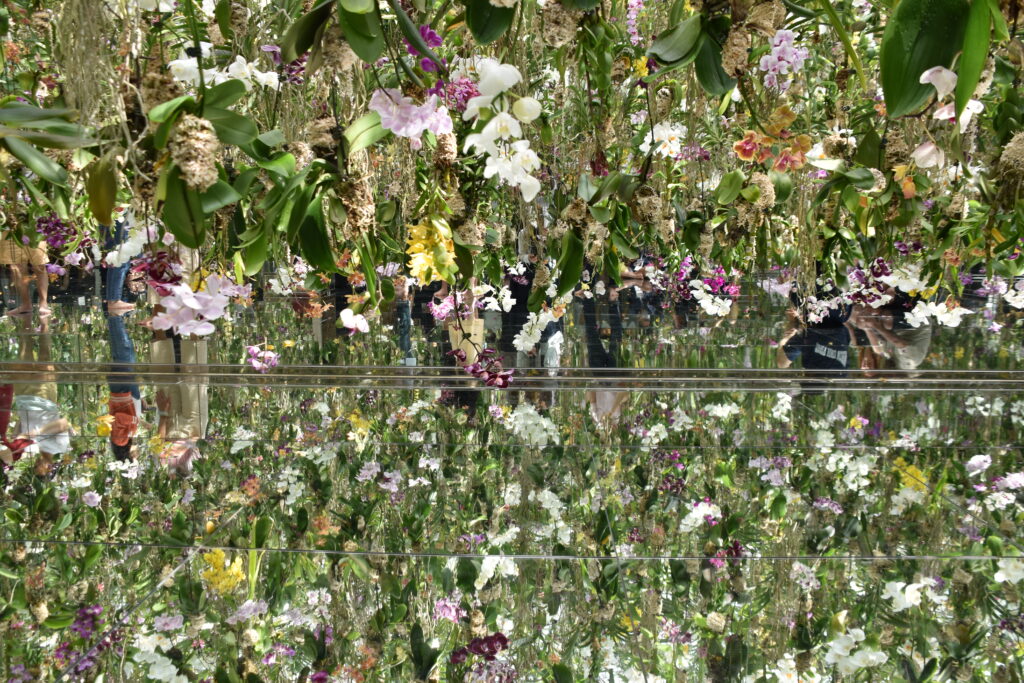
Expressive, Impressive, Overwhelming
The exhibition is not concerned with the visualization of scientific content, although it makes use of its findings in many parts. Rather, it is about quite universal things: What traces do I leave on this planet? How do I interact with the world and with others? How do we and our actions influence each other in the process? In addition, it makes us aware of the fleeting nature of the moment and thus also calls us to perceive impressions with all our senses, with our entire body, to come to rest, to marvel and enjoy, to ultimately become more aware of nature again. And all this happens by confronting us with expressive visual content that impresses us, sometimes almost overburdens us, and leaves us feeling overwhelmed.
A feeling that lasts, as a conversation back at work has made clear to me. I told a colleague that one of the things we visited in Tokyo was an exhibition that used strong visuals. She paused for a moment and then shared that she had also been to such an exhibition on her trip to Japan a few years ago, and that it had left a lasting impression on her: “In one room, you walked in about knee-deep, milky water and were surrounded by koi fish, while another was filled with large free-floating spheres that changed color through interactions with people …”
In 2025, teamLab will also come to Germany with a permanent exhibition in Hamburg’s Hafencity. More info here.

